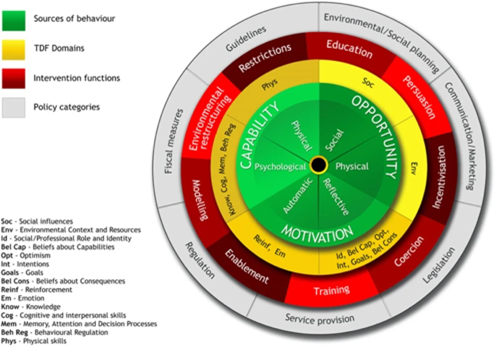BeUpstanding encourages workers to “stand up, sit less, and move more.”
This 8-week program uses a “train-the-champion” approach, equipping workplace leaders with resources like posters, videos, and email templates to promote a culture of movement, resulting in better health, higher productivity, and reduced stress.
But what ensures the program’s effectiveness?
The answer lies in the behavioural change theories that underpin it.
In this blog, we’ll explore how theory guides intervention development and how BeUpstanding uses evidence-based frameworks.
The Importance of Theory in Behaviour Change
Theory is the backbone of behaviour change interventions. It helps designers understand not just the behaviour they aim to change but the context in which it occurs. For BeUpstanding, understanding why people sit at work and what motivates them to move more was crucial.
Further, theories identify triggers and drivers of behaviour, guiding the selection of techniques most likely to succeed in a given context. Without theory, interventions may fail to address the root causes of the behaviour.

Selecting the Right Theory
Choosing the wrong theory or applying it poorly can undermine an intervention. Many interventions fail because they:
- Choose an unsuitable theory,
- Use the theory incorrectly,
- Reference the theory superficially, or
- Address too few behaviour drivers.
For BeUpstanding, the right theory needed to explain why people sit and identify what would motivate them to move more.
It’s not just about understanding behaviour; it’s about understanding how to change it.
Behaviour Theories vs. Change Theories
There’s a distinction between behaviour theories and change theories:
- Behaviour theories explain why people act a certain way. For instance, the Theory of Planned Behaviour examines factors like attitudes, social norms, and perceived control as predictors.
- Change theories focus on processes that encourage behaviour change, guiding intervention design.
BeUpstanding draws on both types of theories—those explaining why people stay sedentary at work and those offering strategies to change that behaviour.
Theoretical Domains Framework (TDF): Understanding Behaviour
To address workplace sitting, BeUpstanding uses the Theoretical Domains Framework (TDF), which integrates constructs from 33 behaviour change theories. TDF helps identify barriers (e.g., lack of awareness or social support) and facilitators (e.g., a culture of movement), enabling BeUpstanding to tailor its intervention to workplace challenges.

The Behaviour Change Wheel (BCW): Turning Theory into Action
After diagnosing the behaviour with the TDF, actionable strategies were developed using the Behaviour Change Wheel (BCW), based on the COM-B model, which identifies three essential components for behaviour change:
- Capability (physical and psychological),
- Opportunity (social and environmental), and
- Motivation (reflective and automatic).

By addressing these elements, BeUpstanding ensures that its intervention tackles not only individual motivation but also the social and environmental factors influencing workplace behaviour.
How BeUpstanding Uses the BCW
In addition, the BCW helped BeUpstanding identify the best Intervention Functions and Policy categories for reducing workplace sitting. These strategies, known as Behaviour Change Techniques (BCTs), are practical and replicable. For example, goal setting and feedback are used to encourage employees to stand more frequently.
By targeting multiple aspects of behaviour—improving physical capability (through education) and altering the physical environment (e.g., standing meetings)—the program becomes more effective.
The BCW also includes policy categories to address organisational factors, such as implementing workplace policies that encourage standing and movement throughout the day.

A Multi-Level Approach
BeUpstanding addresses individual, social, and environmental factors influencing sitting behaviour. Many previous interventions focused solely on individual motivation or ability, ignoring broader social and environmental contexts. By using the COM-B model and BCW, BeUpstanding ensures all levels are addressed, increasing the likelihood of success.
This approach also aligns with evidence that sedentary behaviours are inherently context-specific and influenced by policy and environmental factors, highlighting the importance of addressing multiple levels of influence to effectively reduce sitting time in settings like the workplace. This multi-layered perspective is central to the Social Ecological Model (SEM), which integrates individual, social, and environmental contexts to provide a comprehensive framework for behaviour change and health promotion.
By understanding the barriers and facilitators to reducing sitting, BeUpstanding turns behavioural theories into a practical, evidence-based intervention. The program’s messaging—whether in posters, videos, or emails—reflects this integration of theory, ensuring strategies are grounded in evidence.
BeUpstanding’s success lies in its strong theoretical foundation. Using frameworks like the TDF and BCW ensures the intervention is not a one-size-fits-all solution but a tailored, evidence-based approach for desk-based workers.
Future blogs will explore how these theories support each week of the BeUpstanding program, illustrating how theory translates into practical strategies for getting people moving at work.
This blog was written by Sophie Caruana as part of a fourth-year Psychology placement with the BeUpstanding University of Queensland team.
![]()










Comments are closed.